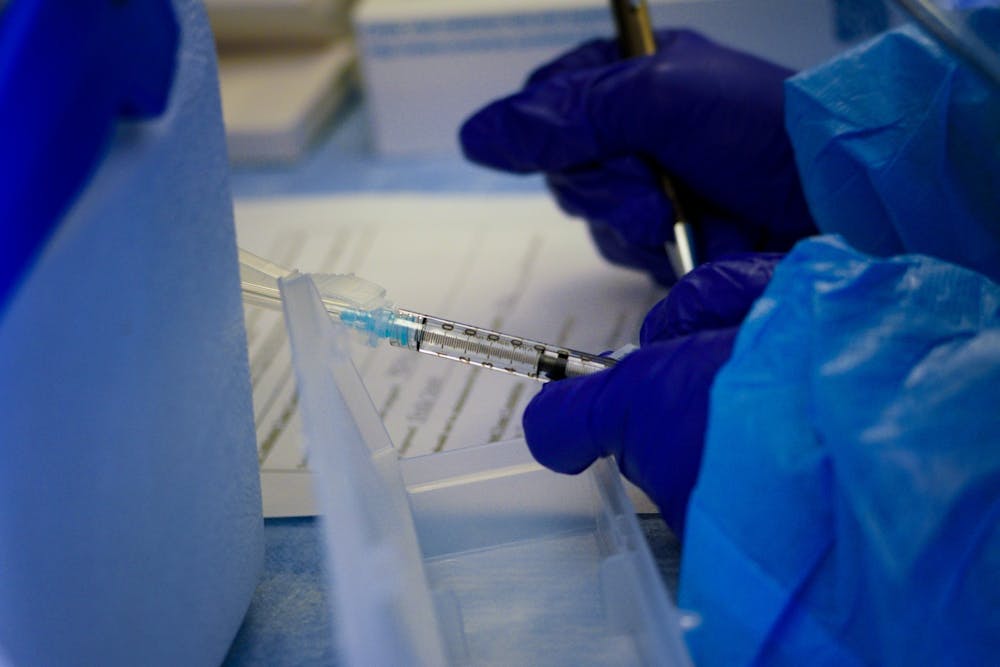Many states, including North Carolina, are preparing to receive COVID-19 vaccine supplies, as Pfizer works to meet Food and Drug Administration expectations for emergency use on its vaccine. Planning for vaccine distribution in North Carolina is being done in four phases — zero through three — according to the 148-page distribution plan outlined by the NC Vaccination Planning Team. There is also a four-phase plan for who gets distributed the vaccine.
COVID-19 cases in North Carolina are increasing and hitting record high numbers as the vaccine approval process begins. Mandy Cohen, secretary for the state department of health and human services, said at a Dec. 3 press briefing that in the past 11 months, COVID-19 has killed more North Carolinians than the flu has in the past decade.
Over 5,000 people have died in North Carolina due to COVID-19 as of Dec. 8, and the state continues to see an increasing positive test rate. Alamance County is in the critical/red tier as of Dec. 8 with a 14-day positivity rate of 10.4%.
Tony Lo Giudice, Alamance County’s new public health director, said in the Dec. 7 county commissioners meeting that the county averaged about 100 new cases of the coronavirus per day last week.
Lo Giudice said the state is preparing for the first shipment of vaccines — containing approximately 85,000 doses — to be sent to North Carolina the week of Dec. 14 if the emergency authorization is granted to Pfizer. As of the meeting, the number of doses Alamance County will receive was unknown.
“They have not proportioned it,” Lo Giudice said at the meeting. “The first set of the dosage will really go to the hospitals first. It’ll be a couple weeks before we start getting some for the health department.”
According to the vaccination plan, all North Carolinians will have equitable access to a vaccine, with “the ultimate goal” to immunize all residents who are eligible and who want a COVID-19 vaccine.
In the planning phase, or phase zero, of the NC vaccination plan, “priority populations” were determined. Priority populations are based on COVID-19 exposure risks, risk of morbidity and mortality and other metrics. In phase one, priority populations such as health care workers, essential workers and long-term care facility staff and residents will receive the first doses available.
According to Lo Giudice, long-term care facilities — which are part of Phase 1b of vaccine distribution — have the ability to partner with pharmacies registered with the state and federal government to provide the vaccine. As soon as doses become available, the state will then give the allotted number of doses to registered pharmacies and providers, who will work with long-term care facilities to vaccinate staff and residents.
“I will say if the need arises and we need to step in as the health department to assist with these long-term care facilities and vaccinations, we’re going to be right there doing it,” Lo Giudice said in the meeting.
Individuals with a higher risk of mortality and morbidity of COVID-19 and people living in close quarters such as congregate care facilities, prisons and homeless shelters, as well as people who work in densely populated areas and frontline workers, will also be prioritized. According to the vaccination plan, historically marginalized populations are “over-represented” in the prioritized populations category.
Alamance County has seen outbreaks — defined as two or more cases in congregate care facilities — in five nursing homes, four long-term care facilities and one homeless shelter, according to information provided by Lo Giudice at the Dec. 7 meeting.
In phase two, when the plan anticipates a larger number of vaccine doses will be available, providers will begin ordering the vaccine based on population needs rather than being allocated doses of the virus, like in phase one. This portion of the plan will require increased access to the vaccine through mass vaccination clinics.
During the transition phase, phase three, it is anticipated that supply of the vaccine could be sufficient or higher than needed. The plan states at this phase, there will be fewer “mass, mobile, or community-based vaccination clinics.”
While the North Carolina plan outlines a possible surplus of vaccine doses, the amount supplied by Pfizer and Moderna are said to be scarce initially — about 22.5 million people could be vaccinated by the end of the year if FDA approval is granted quickly. President Donald Trump’s administration made a $1.95 billion deal with Pfizer over the summer in which the company sold the U.S. 100 million doses. The administration turned down the pharmaceutical company’s offer to secure more doses, according to the New York Times.
The vaccine needs to be kept frozen or ultra-cold, which poses an obstacle to shipping and handling, and each person requires two doses of the vaccine — another challenge facing distribution. Cohen said that in addition to problems shipping, handling and distributing the vaccine, health officials also face the hurdle of public perception.
“Although vaccines were developed quickly over the course of this year, corners were not cut,” Cohen said at the briefing. “The vaccines were built upon years of work in developing vaccines for similar viruses, such as SARS.”
Cohen explained that with billions of dollars invested in vaccines and more than 70,000 participants in clinical trials, the vaccine was developed quickly, but not without effort. Lo Giudice also said that while people need to maintain physical distance and mask wearing to help mitigate the spread of the virus, taking the vaccine will be most important once it becomes available.
“As soon as the vaccine is here and folks are able to get it, get vaccinated,” Lo Giudice said.


